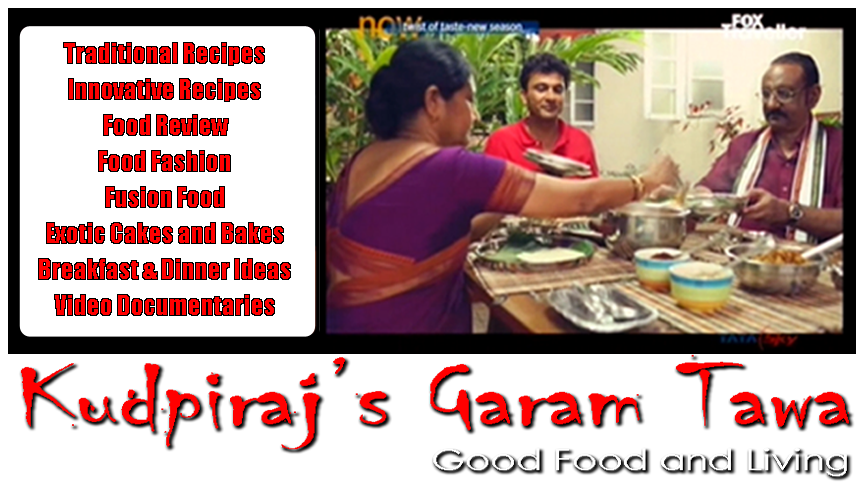Recipe courtesy: Zee Khana Khazana TV show
Arbi or Arvi is nothing but Colocasia or Taro root/tuber. It is commonly found in tropical places, more abundantly in summer and Autumn. It is a rich source of Calcium, phosphorus and carbs. Here in South India, we find it abundantly in Kerala. We GSBs call it Alva Maande.
Though we make different curries like Sambar and Humman with it, Meena found a good recipe on Zee Khana Khazana TV show the other day. She also got some Arbi and prepared it. This dish has an array of spices and flavours that has changed the look and taste of this otherwise not so liked root vegetable. When I looked at it, I knew that it's a super-hit at its very first edition! It reminded me of the chatpata potato/raw plantain dry curry they serve with vegetarian meals in Andhra restaurants.
Spice tangy chatpata Arbi Chips can be eaten directly as a starter snack, a tea time snack, or as a side dish with rice and daal. It's got a typical South Indian touch, especially added curry leaves and Tamarind in it. Make this and surprise your family to a great treat!
Arbi or Arvi is nothing but Colocasia or Taro root/tuber. It is commonly found in tropical places, more abundantly in summer and Autumn. It is a rich source of Calcium, phosphorus and carbs. Here in South India, we find it abundantly in Kerala. We GSBs call it Alva Maande.
Though we make different curries like Sambar and Humman with it, Meena found a good recipe on Zee Khana Khazana TV show the other day. She also got some Arbi and prepared it. This dish has an array of spices and flavours that has changed the look and taste of this otherwise not so liked root vegetable. When I looked at it, I knew that it's a super-hit at its very first edition! It reminded me of the chatpata potato/raw plantain dry curry they serve with vegetarian meals in Andhra restaurants.
Spice tangy chatpata Arbi Chips can be eaten directly as a starter snack, a tea time snack, or as a side dish with rice and daal. It's got a typical South Indian touch, especially added curry leaves and Tamarind in it. Make this and surprise your family to a great treat!
Ingredients:
Arbi - 150Gms(5-7 tubers)
Red Chilli powder - 1/2 Tsp
Coriander powder - 1/2 Tsp
Turmeric powder - 1/4 Tsp
Salt - To taste
Oil - 2 Tsp
Mustard seeds - 1 Tsp
Urad Daal - 1 Tsp
Byadgi/Kashmiri Red Chillies - 2 whole
Curry Leaves - 1/2 Sprig
Thick Tamarind extract - 1 Tsp
Method:
Wash and peel the Arbi roots and slice them into 5mm thick chips.
Boil them with just sufficient water with added salt and drain.
Mix in the powders and keep aside for 10-15 mins.
Heat oil in a pan.
Add mustard seeds and allow them to splutter.
Add urad daal and red chillies.
Fry till urad daal turns golden.
Add curry leaves followed by marinated arbi chips.
Check for salt.
Fry well till the arbi turns almost dry.
Now add the tamarind extract and saute for 2-3 mins.
Switch off the flame and serve hot.
Arbi - 150Gms(5-7 tubers)
Red Chilli powder - 1/2 Tsp
Coriander powder - 1/2 Tsp
Turmeric powder - 1/4 Tsp
Salt - To taste
Oil - 2 Tsp
Mustard seeds - 1 Tsp
Urad Daal - 1 Tsp
Byadgi/Kashmiri Red Chillies - 2 whole
Curry Leaves - 1/2 Sprig
Thick Tamarind extract - 1 Tsp
Method:
Wash and peel the Arbi roots and slice them into 5mm thick chips.
Boil them with just sufficient water with added salt and drain.
Mix in the powders and keep aside for 10-15 mins.
Heat oil in a pan.
Add mustard seeds and allow them to splutter.
Add urad daal and red chillies.
Fry till urad daal turns golden.
Add curry leaves followed by marinated arbi chips.
Check for salt.
Fry well till the arbi turns almost dry.
Now add the tamarind extract and saute for 2-3 mins.
Switch off the flame and serve hot.






























































